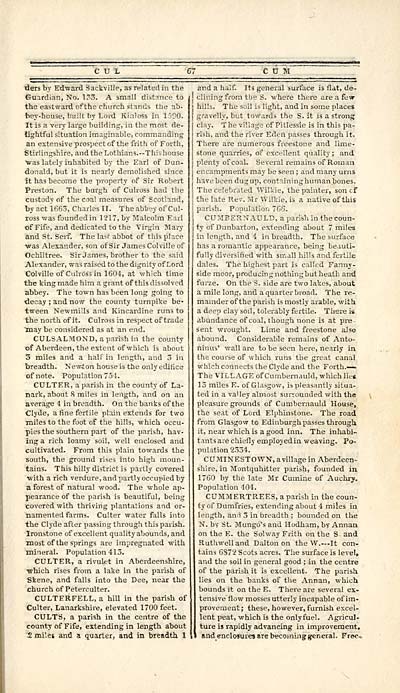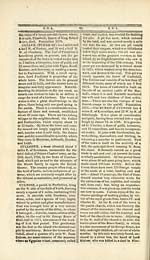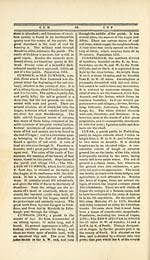Gazetteer of Scotland
(69) Page 67
Download files
Complete book:
Individual page:
Thumbnail gallery: Grid view | List view

C U X
tiers by Edward Sackville, as related in the
Guardian, No. 133. A small distance to
the eastward of the church stands the ab-
bey-house, built by Lord Kinloss in 1500.
It is a very large building, in the most de-
lightful situation imaginable, commanding
an extensive prospect of the frith of Forth,
Stirlingshire, and the Lothians.-This house
was lately inhabited by the Earl of Dun-
donald, but it is nearly demolished since
it has become the property of Sir Robert
Preston. The burgh of Culross had the
custodv of the coal measures of Scotland,
by act 1663, Charles II. The abbey of Cul-
ross was founded in 1217, by Malcolm Earl
Of Fife, and dedicated to the Virgin Mary
and St. Serf. The last abbot of this place
■was Alexander, son of Sir James Colville of
Ochiltree. Sir James, brother to the said
Alexander, was raised to the dignity of Lord
Colville of Culross in 1604, at which time
the king made him a grant of this dissolved
abbey. The town has been long going to
decay ; and now the county turnpike be-
tween Newmills and Kincardine runs to
the north of it. C ulross in respect of trade
Inay be considered as at an end.
CULSALMOND, a parish in the county
of Aberdeen, the extent of which is about
3 miles and a half in length, and 3 in
breadth. New-ton house is the only edifice
of note. Population 754.
COLTER, a parish in the county of La-
nark, about 8 miles in length, and on an
average 4 in breadth. On the banks of the
Clyde, a fine fertile plain extends for two
miles to the foot of the hills, which occu-
pies the southern part of the parish, hav-
ing a rich loamy soil, well enclosed and
cultivated. From this plain towards the
south, the ground rises into high moun-
tains. This hilly district is partly covered
with a rich verdure, and partly occupied by
a forest of natural wood. The whole ap-
pearance of the parish is beautiful, being
covered with thriving plantations and or-
namented farms. Culter water falls into
the Clyde after passing through this parish.
Ironstone of excellent quality abounds, and
most of the springs are impregnated with
mineral. Population 413.
CULTER, a rivulet in Aberdeenshire,
■which rises from a lake in the parish of
Skene, and falls into the Dee, near the
church of Peterculter.
CULTERFELL, a hill in the parish of
Culter, Lanarkshire, elevated 1700 feet.
CULTS, a parish in the centre of the
county of Fife, extending in length about
2 miles and a quarter, and in breadth 1
CUM
and a half. Its general surface is flat, de-.
clir.ing from the S. where there are a few-
hills. The soil is light, and in some places
gravelly, but. towards the S. it is a strong
lay. The village of Pitlessie is in this pa-
ish, and the river Edeii passes through it.
There are numerous freestone and lime-
stone quarries, of excellent quality; and
plenty of coal. Several remains of Roman
encampments may be seen ; and many urns
have been dug up, containing human bones.
The celebrated Wilkie, the painter, son cf
the late Rev. Mr Wilkie, is a native of this
parish. Population 765.
CUMBERNAULD, a parish in the coun-
ty of Dunbarton, extending about 7 miles
in length, and 4 in breadth. The surface
has a romantic appearance, being beauti-
fully diversified with small hills and fertile
dales. The highest part is called Fanny-
side moor, producingnothingbutheath and
furze. On the S. side are two lakes, about
a mile long, and a quarter broad. The re-
mainder of the parish is mostly arable, with
a deep clay soil, tolerably fertile. There is
abundance of coal, though none is at pre-
sent wrought. Lime and freestone also
abound. Considerable remains of Anto-
ninus' wall are to be seen here, nearly in
the course of which runs the great canal
which connects the Clyde and the Forth.—
The VILLAGE of Cumbernauld, which lie*
13 miles E. of Glasgow, is pleasantly situa-
ted in a valley almost surrounded with the
pleasure grounds of Cumbernauld House,
the seat of Lord Elphinstone. The road
from Glasgow to Edinburgh passes through
it, near which is a good inn. The inhabi-
tantsare chiefly employedin weaving. Po-
pulation 2334.
CUMINESTOWN, avillage in Aberdeen-
shire, in Montquhitter parish, founded in
1760 by the late Mr Cumine of Auchry.
Population 404.
CUMMERTREES, a parish in the coun-
ty of Dumfries, extending about 4 miles in
length, and 3 in breadth ; bounded on the
N. by St. Mungo's and Hodham, by Annan
on the E. the Solway Frith on the S and
Ruthwelland Dalton on the W.— It con-
tains 6S72 Scots acres. The surface is level,
and the soil in general good ; in the centre
of the parish it is excellent. The parish
lies on the banks of the Annan, which
bounds it on the E. There are several ex-
tensive flow mosses utterly incapable of im-
provement; these, however, furnish excel-
lent peat, which is the onlyfuel. Agricul-
ture is rapidly advancing in improvement,
and enclosure* are becoming general. Frec~
tiers by Edward Sackville, as related in the
Guardian, No. 133. A small distance to
the eastward of the church stands the ab-
bey-house, built by Lord Kinloss in 1500.
It is a very large building, in the most de-
lightful situation imaginable, commanding
an extensive prospect of the frith of Forth,
Stirlingshire, and the Lothians.-This house
was lately inhabited by the Earl of Dun-
donald, but it is nearly demolished since
it has become the property of Sir Robert
Preston. The burgh of Culross had the
custodv of the coal measures of Scotland,
by act 1663, Charles II. The abbey of Cul-
ross was founded in 1217, by Malcolm Earl
Of Fife, and dedicated to the Virgin Mary
and St. Serf. The last abbot of this place
■was Alexander, son of Sir James Colville of
Ochiltree. Sir James, brother to the said
Alexander, was raised to the dignity of Lord
Colville of Culross in 1604, at which time
the king made him a grant of this dissolved
abbey. The town has been long going to
decay ; and now the county turnpike be-
tween Newmills and Kincardine runs to
the north of it. C ulross in respect of trade
Inay be considered as at an end.
CULSALMOND, a parish in the county
of Aberdeen, the extent of which is about
3 miles and a half in length, and 3 in
breadth. New-ton house is the only edifice
of note. Population 754.
COLTER, a parish in the county of La-
nark, about 8 miles in length, and on an
average 4 in breadth. On the banks of the
Clyde, a fine fertile plain extends for two
miles to the foot of the hills, which occu-
pies the southern part of the parish, hav-
ing a rich loamy soil, well enclosed and
cultivated. From this plain towards the
south, the ground rises into high moun-
tains. This hilly district is partly covered
with a rich verdure, and partly occupied by
a forest of natural wood. The whole ap-
pearance of the parish is beautiful, being
covered with thriving plantations and or-
namented farms. Culter water falls into
the Clyde after passing through this parish.
Ironstone of excellent quality abounds, and
most of the springs are impregnated with
mineral. Population 413.
CULTER, a rivulet in Aberdeenshire,
■which rises from a lake in the parish of
Skene, and falls into the Dee, near the
church of Peterculter.
CULTERFELL, a hill in the parish of
Culter, Lanarkshire, elevated 1700 feet.
CULTS, a parish in the centre of the
county of Fife, extending in length about
2 miles and a quarter, and in breadth 1
CUM
and a half. Its general surface is flat, de-.
clir.ing from the S. where there are a few-
hills. The soil is light, and in some places
gravelly, but. towards the S. it is a strong
lay. The village of Pitlessie is in this pa-
ish, and the river Edeii passes through it.
There are numerous freestone and lime-
stone quarries, of excellent quality; and
plenty of coal. Several remains of Roman
encampments may be seen ; and many urns
have been dug up, containing human bones.
The celebrated Wilkie, the painter, son cf
the late Rev. Mr Wilkie, is a native of this
parish. Population 765.
CUMBERNAULD, a parish in the coun-
ty of Dunbarton, extending about 7 miles
in length, and 4 in breadth. The surface
has a romantic appearance, being beauti-
fully diversified with small hills and fertile
dales. The highest part is called Fanny-
side moor, producingnothingbutheath and
furze. On the S. side are two lakes, about
a mile long, and a quarter broad. The re-
mainder of the parish is mostly arable, with
a deep clay soil, tolerably fertile. There is
abundance of coal, though none is at pre-
sent wrought. Lime and freestone also
abound. Considerable remains of Anto-
ninus' wall are to be seen here, nearly in
the course of which runs the great canal
which connects the Clyde and the Forth.—
The VILLAGE of Cumbernauld, which lie*
13 miles E. of Glasgow, is pleasantly situa-
ted in a valley almost surrounded with the
pleasure grounds of Cumbernauld House,
the seat of Lord Elphinstone. The road
from Glasgow to Edinburgh passes through
it, near which is a good inn. The inhabi-
tantsare chiefly employedin weaving. Po-
pulation 2334.
CUMINESTOWN, avillage in Aberdeen-
shire, in Montquhitter parish, founded in
1760 by the late Mr Cumine of Auchry.
Population 404.
CUMMERTREES, a parish in the coun-
ty of Dumfries, extending about 4 miles in
length, and 3 in breadth ; bounded on the
N. by St. Mungo's and Hodham, by Annan
on the E. the Solway Frith on the S and
Ruthwelland Dalton on the W.— It con-
tains 6S72 Scots acres. The surface is level,
and the soil in general good ; in the centre
of the parish it is excellent. The parish
lies on the banks of the Annan, which
bounds it on the E. There are several ex-
tensive flow mosses utterly incapable of im-
provement; these, however, furnish excel-
lent peat, which is the onlyfuel. Agricul-
ture is rapidly advancing in improvement,
and enclosure* are becoming general. Frec~
Set display mode to: Large image | Transcription
Images and transcriptions on this page, including medium image downloads, may be used under the Creative Commons Attribution 4.0 International Licence unless otherwise stated. ![]()
| Gazetteers of Scotland, 1803-1901 > Gazetteer of Scotland > (69) Page 67 |
|---|
| Permanent URL | https://digital.nls.uk/97422522 |
|---|

